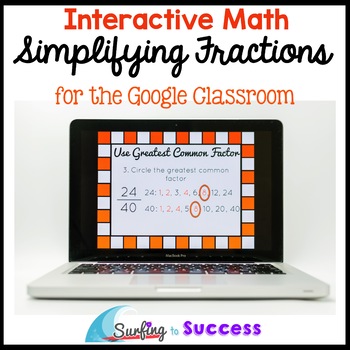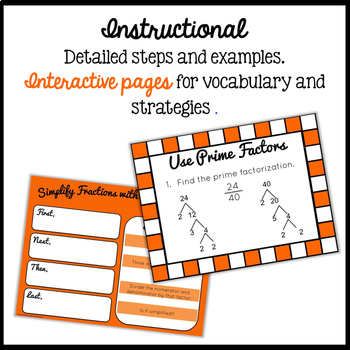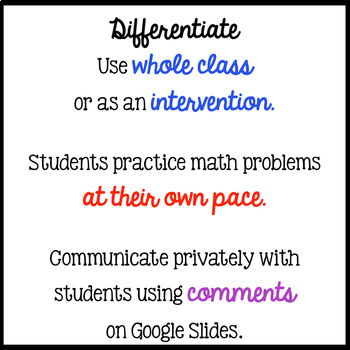Simplify Fractions: Interactive Math for the Google Classroom
Mercedes Hutchens
7.3k Followers
Grade Levels
4th - 6th, Homeschool
Subjects
Resource Type
Standards
CCSS3.NF.A.3
CCSS4.NF.A.1
CCSS5.NF.A.1
Formats Included
- PDF
- Google Apps™
Pages
72 pages
Mercedes Hutchens
7.3k Followers

Includes Google Apps™
The Teacher-Author indicated this resource includes assets from Google Workspace (e.g. docs, slides, etc.).
What educators are saying
I used this at the beginning of 6th grade. This was very helpful reminding them how to simplify fractions.
Also included in
- Digital interactive math resources for your Google Classroom. This bundle has math resources that fifth grade students can use with Google Slides. They can focus on one problem at a time. Digital resources can be so helpful because the color coding helps students focus on one part at a time.Price $43.20Original Price $48.00Save $4.80
Description
Digital interactive lesson and practice for Simplifying Fractions. This interactive Google Slides resource allows students to work at their own pace. Simplify Fractions with Prime Factorization, Greatest Common Denominator, and Mental Division. This works well for whole class or intervention. A Google Forms Quiz is provided to assess success.The student resource contains self checking math problems and the quiz has a built in answer key which will save you time< as well as paper.
Based on my Simplifying Fractions PowerPoint.
Common Core Math Standard: 3.NF.A.3, 4.NF.A.1, 5.NF.A.1
Description of the Student Resource
•1-2: Introduction and Directions
•3-12 Introduce Vocabulary (numerator, denominator, factors, common factors, greatest common factors, prime factors, equivalent)
•13 Interactive Vocabulary (digital interactive notebook pages)
•14 Introduce 3 Strategies
•15-24 Step by Step instruction for Simplifying Fractions using Prime Factors
•25 Interactive Notebook Page for using Prime Factors
•26-30 Student Interactive Practice Problems
•31-37 Step by Step instruction for Simplifying Fractions using Greatest Common Factor (GCF)
•38 Interactive Notebook Page for GCF
•39-42 Student Interactive Practice Problems
•43-51 Step by Step instruction for Simplifying Fractions using Mental Division
•52 Interactive Notebook Page for Mental Division
•53-55 Student InteractivePractice Problems
•56-57 Choosing a Strategy
•58- Students reflection writing about which strategy they will choose to use
•59-69 Student Interactive Practice Problems
•70-72 Standards Posters
Separate: Google Forms Quiz
Based on my Simplifying Fractions PowerPoint.
Common Core Math Standard: 3.NF.A.3, 4.NF.A.1, 5.NF.A.1
Description of the Student Resource
•1-2: Introduction and Directions
•3-12 Introduce Vocabulary (numerator, denominator, factors, common factors, greatest common factors, prime factors, equivalent)
•13 Interactive Vocabulary (digital interactive notebook pages)
•14 Introduce 3 Strategies
•15-24 Step by Step instruction for Simplifying Fractions using Prime Factors
•25 Interactive Notebook Page for using Prime Factors
•26-30 Student Interactive Practice Problems
•31-37 Step by Step instruction for Simplifying Fractions using Greatest Common Factor (GCF)
•38 Interactive Notebook Page for GCF
•39-42 Student Interactive Practice Problems
•43-51 Step by Step instruction for Simplifying Fractions using Mental Division
•52 Interactive Notebook Page for Mental Division
•53-55 Student InteractivePractice Problems
•56-57 Choosing a Strategy
•58- Students reflection writing about which strategy they will choose to use
•59-69 Student Interactive Practice Problems
•70-72 Standards Posters
Separate: Google Forms Quiz
Total Pages
72 pages
Answer Key
N/A
Teaching Duration
1 Year
Report this resource to TPT
Reported resources will be reviewed by our team. Report this resource to let us know if this resource violates TPT’s content guidelines.
Standards
to see state-specific standards (only available in the US).
CCSS3.NF.A.3
Explain equivalence of fractions in special cases, and compare fractions by reasoning about their size.
CCSS4.NF.A.1
Explain why a fraction 𝘢/𝘣 is equivalent to a fraction (𝘯 × 𝘢)/(𝘯 × 𝘣) by using visual fraction models, with attention to how the number and size of the parts differ even though the two fractions themselves are the same size. Use this principle to recognize and generate equivalent fractions.
CCSS5.NF.A.1
Add and subtract fractions with unlike denominators (including mixed numbers) by replacing given fractions with equivalent fractions in such a way as to produce an equivalent sum or difference of fractions with like denominators. For example, 2/3 + 5/4 = 8/12 + 15/12 = 23/12. (In general, 𝘢/𝘣 + 𝘤/𝘥 = (𝘢𝘥 + 𝘣𝘤)/𝘣𝘥.)






